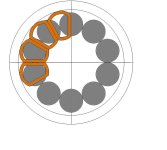thepronghorn
1 kW
I am thinking about building a smallish, low power axial flux motor as an experiment and test to see if it would be feasible and reasonable to build a higher power version for usage on my bike. I want to be able to mount a sprocket to it, so it needs to have some rotating shaft or side disc where a sprocket could mount. I have some questions about the design so some help would be appreciated.
Planned details:
Coreless to keep it simple, cheap
5" diameter
2 rotors, 1 stator
Thin magnet wire to reduce eddy currents in the copper
Stator coils glued together with some sort of epoxy (What sort of glue/epoxy would be good for this application?)
1/8" thick magnets, 3/8" thick stator (What would be a good stator to magnet thickness ratio?)
1/8" thick back iron for rotors (Is this enough?)
circular magnets (Using fewer magnets means the magnets can be larger in diameter. What are the drawbacks to using 8 large magnets (1.5" diameter) as opposed to something like 16 smaller magnets?)
I hope to be able to build this at home using just a drill press and some hole saws to make all the round parts. Obviously the motor will not be perfectly balanced but by close attention to detail I hope to get pretty close. Any other comments or suggestions?
Planned details:
Coreless to keep it simple, cheap
5" diameter
2 rotors, 1 stator
Thin magnet wire to reduce eddy currents in the copper
Stator coils glued together with some sort of epoxy (What sort of glue/epoxy would be good for this application?)
1/8" thick magnets, 3/8" thick stator (What would be a good stator to magnet thickness ratio?)
1/8" thick back iron for rotors (Is this enough?)
circular magnets (Using fewer magnets means the magnets can be larger in diameter. What are the drawbacks to using 8 large magnets (1.5" diameter) as opposed to something like 16 smaller magnets?)
I hope to be able to build this at home using just a drill press and some hole saws to make all the round parts. Obviously the motor will not be perfectly balanced but by close attention to detail I hope to get pretty close. Any other comments or suggestions?


